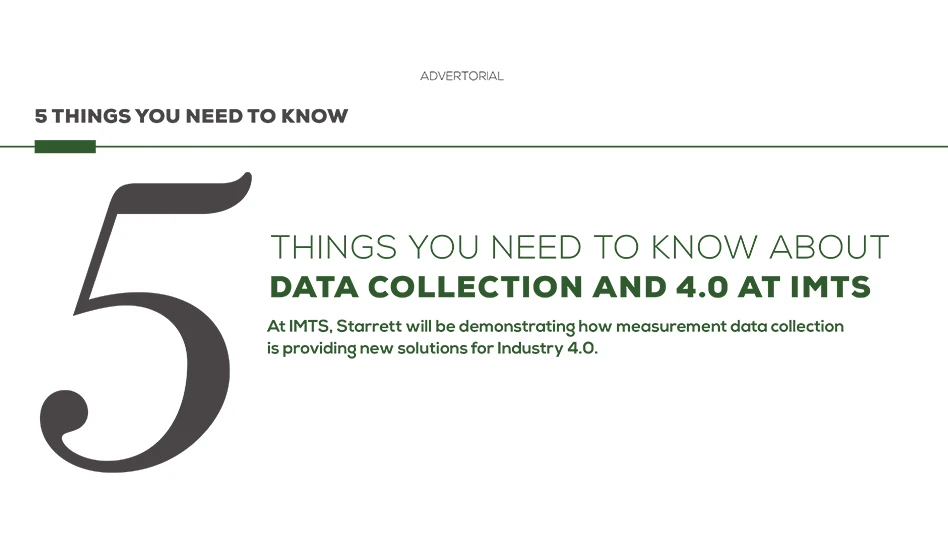
GIE Media

The L.S. Starrett Co. offers insights about how Wireless Measurement Data Collection software systems work with wireless electronic gages and metrology systems to increase productivity, reduce errors, provide full documentation, and automate the acquisition process.
Supporting Industry 4.0, IoT, and the Digital Factory, attendees can see for the first time at a major live event, demonstrations of automated wireless measurement data capture and transmission from handheld wireless/electronic gages via the new DataSure 4.0 Wireless Data Collection System, or from Vision Systems and Optical Comparators via integrated software. Visit IMTS Booth #135044 to see it applied.
1 Accurate, consistent, and secure measurement data acquisition is key, including over long distances.
Today’s wireless measurement data collection systems should be complete, scalable, secure, and robust. That means offering foundational benefits through automation, ease of operation, streamlined scalability, robust data encryption/protection, and unrestricted distances/unencumbered use for transmission.
2 Wireless gages must be fully featured and reliable.
Using gages with internal embedded wireless measurement capability is highly efficient. For those without the embedded capability, backpack radios, which are unobtrusive and easily attached, can expand functionality. It’s also efficient to use end nodes and rechargeable wireless measuring tools, and tools that offer IP67 level protection.
3 New versatile network topology structure can be configured to many simple or complex situations and distributed remote gateways can also be used.
The modular structure of today’s systems makes it simple to expand or contract a quality control measurement data collection process without having to acquire a new data collection system. The latest measurement data collection systems are adaptable to nearly every use case, such as 100% measurement of all parts/ components in highly regulated industries such as aerospace and defense.
4 Scalability can range from simple to extended enterprise schemes.
In its simplest application, a portable scheme features a wireless app running on a mobile device. The straightforward setup can have one wireless measuring tool with an embedded radio transmitting data up to 30ft (10m) to a mobile device or may have 5 to 8 measuring tools connected to the mobile app for data transmission up to 30ft (10m). Also, data can easily be transmitted up to 30ft (10m) from one (or more) wireless measuring tool(s) to a laptop or PC with a USB gateway. Additional schemes increase the number of tools and transmission distance, going up to an enterprise scheme, where measurement data transmission can be increased from hundreds of yards to over a mile. By using remote gateways, bridges, and repeaters, more than 100 measuring tools can be incorporated.
5 Metrology systems’ wireless measurement data transmission.
To meet Industry 4.0 requirements, metrology equipment must be able to communicate across the company network in real time so potential issues can be spotted before they manifest. Via integrated software, vision systems and optical comparators operators can transmit critical precision measurement and inspection data directly to their computer or mobile device.
FOR MORE INFORMATION: The L.S. Starrett Co. IMTS Booth #135044


Explore the August September 2022 Issue
Check out more from this issue and find your next story to read.
Latest from Aerospace Manufacturing and Design
- Revitalizing the Defense Maritime Industrial Base with Blue Forge Alliance
- Safran Defense & Space opens US defense HQ
- Two miniature absolute encoders join US Digital’s lineup
- Lockheed Martin completes Orion for Artemis II
- Cylinder CMMs for complex symmetrical workpieces
- University of Oklahoma research fuels UAS development
- Motorized vision measuring system
- Everyone's talking tariffs





